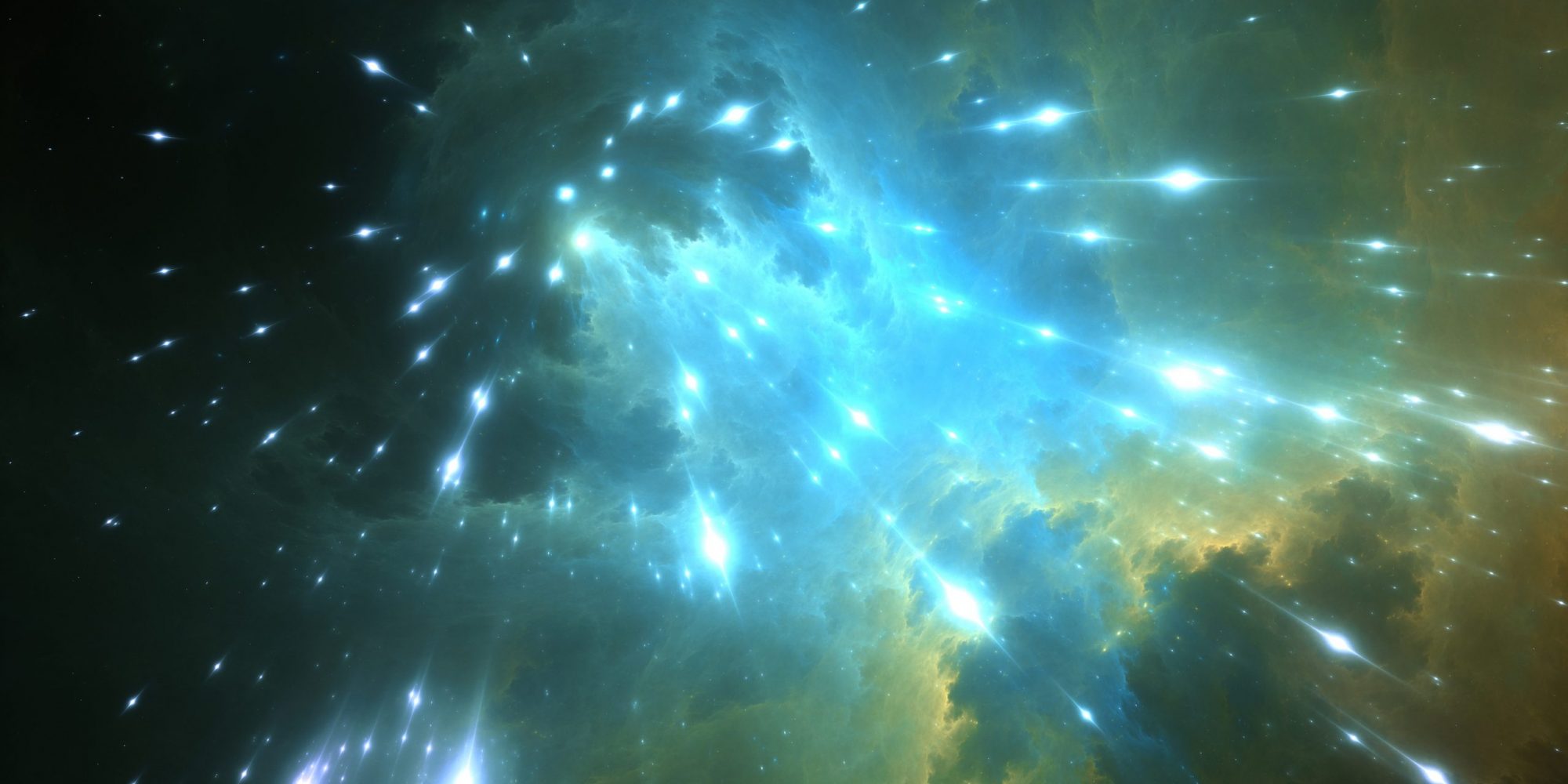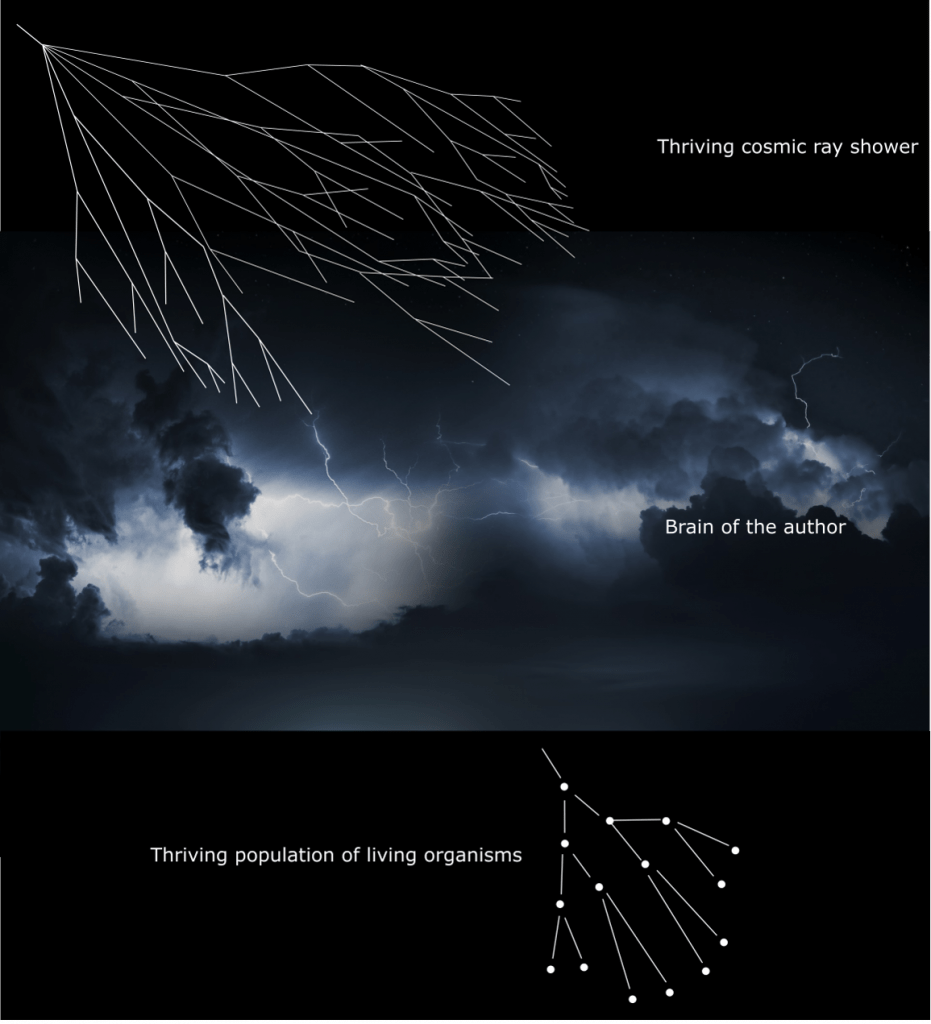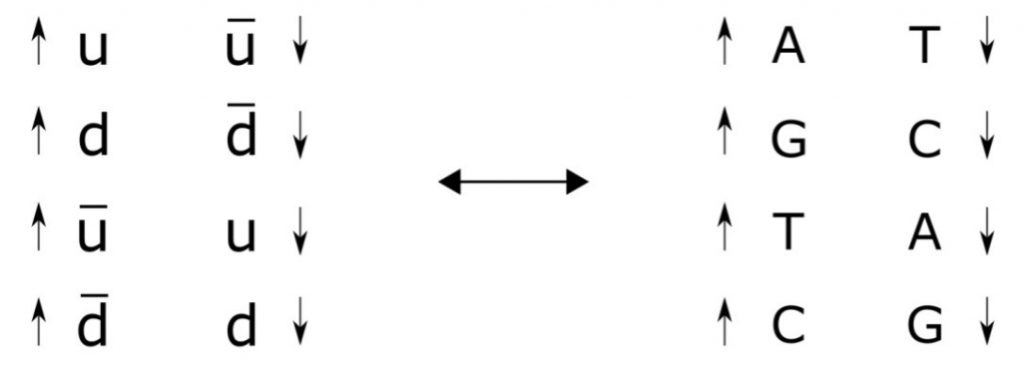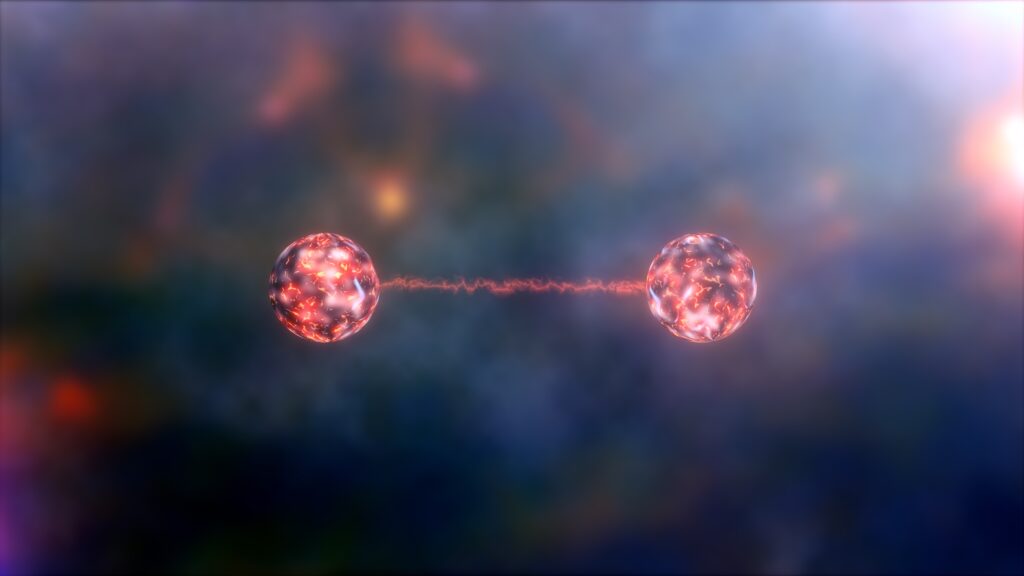Mind may be older than we think
Reading | Abiogenesis | 2022-03-20

We may have reasons to believe that life is an intentional work of art; and not a very original one, for it may be based on a form of planetary imitation! This article is a continuation of the authors’ popular previous essay.
The purpose of this essay is to show that mind may be older than is currently thought. More specifically, we wish to demonstrate that there is sufficient reason to seriously consider ascribing an earlier date to the appearance of individuated consciousness within the timeline of our universe.
Because of the privateness of conscious experience, no one can be sure that consciousness is exclusively the preserve of humans, higher primates or mammals; nevertheless, its existence is typically considered as a possibility solely within the animal kingdom. This is due to the fact that animals have developed nervous systems to a greater or lesser degree; and also that our own conscious experience is closely related to the neural activity of our brain.
The argument that mind appeared earlier than 600 million years ago, therefore prior to the appearance of the first animals endowed with primordial neural networks, is considered entirely unfounded. In our universe, which is about 13.7 billion years old, the appearance of mind is thus thought to be quite recent, and an event that pertains strictly to life as we know it here on Earth.
It could certainly be argued that forms of animal life may have appeared far earlier on other planets. However, investigating this possibility is beyond the scope of the current paper. Rather, we will continue to pursue the line of research that we began to illustrate in the essay entitled ‘Conscious storms and the origin of life,’ revisiting it here from a different perspective. In the latter essay, we showed that the mind-matter problem should be given more serious consideration, since it can potentially question the certainties we have about the nature of living organisms. In fact, we argued that, although governed by blind, purposeless laws of nature, the Earth’s atmosphere—just like the biological brain—may be associated with a subjective first-person perspective and may have, therefore, purposely created life on Earth.
The aforementioned essay implicitly opens up the possibility that mind is older than currently thought, and that it is not necessarily unique to the animal kingdom, or exclusive to living organisms as a whole. We intend to develop this theme here by asking the following question: how do we render more plausible the possibility that there actually was—and perhaps still is—conscious experience related to the activity of the atmospheric system? In our earlier essay, we highlighted the similarities between this system and our brain; here we will follow a different approach.
If we were to consider the possibility that life on Earth is the work of an author—possibly the Earth itself—there would still be something about life that we would need to further comprehend. In other words, our current understanding would be limited to a mere reduction of life to a physico-chemical process, yet its meaning as the creation of an author would remain absolutely obscure, simply because we never entertained the possibility that it could have such a meaning. Resorting to a metaphor, this would be akin to studying a painting, such as the “Narciso” by Caravaggio, by simply attempting to ascertain the chemical composition of the colors and the physical structure of the canvas. Our understanding of the physico-chemical aspects of the object might well be advanced, and we might also be able to identify some recurring patterns in the image, yet the meaning of the work—a depiction of Narcissus looking at his own reflection in a body of water—would escape us entirely.
We therefore propose the following approach: we will attempt to gain an understanding of what life is by acknowledging that it actually could be the product of a conscious author, for whom it is endowed with meaning. In attempting to shed light on what this meaning could be, we will try to understand what life represents for its supposed author. If we were to find a satisfactory answer to this question, we would have made the initial hypothesis more plausible; namely, that life was intentionally created by planet Earth, and that the latter should no longer be conceived of solely as a physical object, but also as a conscious subject whose mind, observed from a third person perspective, appears as the electromagnetic activity of the Earth’s atmospheric system.
Paraphrasing Wilczek’s beautiful question (Wilczek, 2016) “Is the universe a work of art?”, here we are narrowing the question down to “Is life a work of art?” In order to understand what life can represent for its author, we must go in search of what they perceived. Is there something that comes from the outer environment, which has a causal power on the activity of the Earth’s ‘brain’? Are there any physical entities coming from outer space, which impact the Earth and trigger atmospheric discharges?
Despite being one of the most familiar and widely recognized natural phenomena, lightning discharges still remain relatively poorly understood (J. R. Dwyer, 2014); the main problem with lightning physics being that the electrical fields that occur between the clouds (10-100kV/m) are typically an order of magnitude lower than those required for the dielectric breakdown of the atmosphere (2MV/m). Thus, the physical mechanism that initiates many lightning strikes is not yet completely clear.
Furthermore, during thunderstorms X-ray flashes (50keV ) and γ-ray flashes (0, 05 − 10MeV ) are detected. Gurevich et al. (A.V. Gurevich, 1999) argues that the existence of high-energy emissions indicates that relativistic electrons must play a significant role in thundercloud discharge. Therefore, the initiation mechanism proposed is a relativistic runaway electron avalanche (RREA). Without delving into the study in any great detail, the proposed mechanism essentially entails the presence of highly energetic particles, which can lower to 200 kV/m the threshold of the electric field necessary for an atmospheric discharge to occur.
Thus, an atmospheric discharge can be stimulated by high energy particles provided by an extensive atmospheric cosmic ray shower. According to this approach, cosmic rays play a decisive role in initiating atmospheric discharges, in which clouds (under certain conditions) essentially constitute natural versions of an old type of particle detector: the spark chamber. If we acknowledge that the discharges directly induced by these events may induce others in turn, the whole process of discharging is analogous to what happens in our brain when visible photons impact our retinas, and we know that corresponding to such brain activity we experience a visual perception of an object or an event.
Therefore, if we acknowledge the possibility that there is subjective experience related to the atmospheric discharges with which we are dealing, we can infer that the content of this experience will be some form of perception of the cosmic ray impact events. A perception of this type is obviously very difficult for us to imagine, at least as difficult as trying to imagine what it is like to be a bat, whose perception mechanism based on echolocation is very different from ours, as Nagel points out in his well-known paper. Humans do not have dedicated receptors to perceive these physical events and must reconstruct them using specific detectors and accurate data processing, which happens daily in several cosmic ray physics experiments.
We can attempt to find elements in common between the physics of these events and the salient characteristics of life. Essentially, we wish to understand whether life can be considered the product of a creative process in which what is perceived by the author is reworked and represented. If in the previous essay we ventured into a comparative study between the Earth’s atmospheric system and the brain of an author, it is now time to try our hand at a comparative study between the physics of cosmic rays and living organisms.
In an attempt to arrive at a deeper understanding of what life is, we offer the following analogy: Earth takes on the role of van Gogh as he perceives the actual sunflowers and produces their representation, while cosmic ray showers take on the role of physical sunflowers and living organisms are their representation. That is to say, living organisms are a product of the Earth inspired by cosmic ray shower physics. In fig. 1 these three elements are illustrated: the perceived phenomenon (showers), the author’s brain (the atmospheric system), and his creation (the first living organisms).

Figure 1. The proposed scenario for the origin of life.
Such cosmic rays (mainly protons coming from outer space), through interaction with atomic nuclei in the atmosphere (mainly nitrogen nuclei), determine the production of other particles, which in turn interact with atmospheric nuclei, leading to the production of further particles. As far as such products have enough energy, the process can be reiterated and the result is a ‘shower’ of particles, which is typically referred to as a cosmic ray shower. During the first phase of a shower, the number of particles is subject to a phase of exponential growth. This growth ceases when the energy of the produced particles is too low. A decay phase then follows, since most of the particles produced in the shower have a finite lifetime. This latter phase, in which the population of particles is decimated, is likewise exponential.
Similarly, in a bacterial culture, after a first phase of exponential population growth, a phase of exponential decrease follows. More generally, in a population of organisms exponential growth and decrease compete with one another according to the environmental conditions in which the organisms are found. As in the case of cosmic ray showers, exponential growth dominates when there is enough energy available in the environment in which the organisms live, otherwise exponential decrease dominates.
We now want to delve deeper into those characteristics that are common to cosmic ray atmospheric phenomena and phenomena pertaining to living organisms. Since even the simplest living organisms are extraordinarily complex systems, it is quite natural to focus our attention on the more complex physical objects that are produced in a cosmic ray shower. As we know, the constituent particles of matter are grouped into two large classes: quarks and leptons. While leptons are isolated particles in cosmic air showers, quarks form so-called ‘bound states.’ Physical systems made up of quarks constitute the class of hadrons. Hadrons are composite subatomic particles made up of two or more quarks held together. As an example, the most famous hadrons are the proton p and the neutron n, the constituents of the atomic nucleus. We want to demonstrate that, among all the particles produced in a shower, there is at least one that can be considered a living organism: the neutral pion , which is the lightest and thus most easily produceable hadron. While the proton and the neutron are made up of three quarks, the neutral pion consists of a quark and its respective antiquark, as shown in the top drawing in fig. 2a. Such particle pairs are thought of as confined in a bag, which separates the pion from the outer environment.
So let us consider what happens if we supply energy to a physical system such as the neutral pion (fig. 2a). When the energy available within the environment of this system is absorbed in an interaction, it is used to draw apart the constituent quark and antiquark. When this process reaches a certain threshold, a portion of the absorbed energy is converted into the mass of a new pair. The newly created quark binds to the pre-existing antiquark while the newly created antiquark binds to the pre-existing quark, giving rise to two ‘children’ hadrons starting from a single ‘parent’ hadron. Since the pion is the lightest hadron, it is possible to ensure that the two children hadrons are still two neutral pions, identical to the initial one, provided that the absorbed energy is below a certain threshold. In this case, each of the children hadrons thus possesses the same quark structure as the parent hadron, which is replicated during the latter’s reproduction process. Once the new pair is produced, the splitting of the bag completes the fission process. If, on the other hand, this energy is not supplied in time, the initial pion simply decays: its existence comes to an end as it decays into a photon pair. The latter instances typically occur in a cosmic air shower, given the short lifetime of the neutral pions. These are some of the interesting peculiarities of these objects located above the clouds. Let us now observe what is happening below the clouds, within the living organisms.
Fundamentally, a living organism is a thermodynamic system that dissipates energy available in its environment in order to reproduce itself. This energy dissipation is due to metabolism, a process in which the organism autonomously synthesizes the molecules necessary for its reproduction. In practice, in order to reproduce itself, an organism must necessarily replicate its DNA, and to do so it must be able to autonomously synthesize the four distinct nucleotides of which the DNA is made up: A, T, G, C. In this synthesis process a certain amount of available energy is transformed into the mass of nucleotides. The term ‘metabolism’ indicates precisely this transformation. The transformation of energy into mass is much more marked in nuclear and particle physics reactions than in chemical reactions; yet, from the point of view of fundamental physics, it is the same transformative process. Finally, the splitting of the membrane completes the binary fission process of a simple living organism (fig. 2b).

Figure 2. (a) Fission of a pion. (b) Binary fission of a living organism.
The process of fission of a neutral pion can similarly be described in terms of metabolism, replication and, finally, reproduction through the splitting of the membrane which separates it from its outer environment. For these reasons we believe that, to all intents and purposes, it can be considered a living organism.
Undoubtedly, another striking difference between a neutral pion and a living organism is that, in the latter, its defining replicated internal structure is a double antiparallel strand (DNA), whereas in the case of a neutral pion it is simply a pair. In this regard, it is useful to investigate the neutral pion’s quark structure.
As a quantum system, the state of the neutral pion is a superposition of states of a system made up of a pair. The quantum state of each quark is defined by their so-called ‘flavor’ and ‘spin’ properties. In practice, each neutral pion is therefore a superposition of 4 spin-flavor states. It is possible to place these four states in one-to-one correspondence with the four possible pairs of nucleotides that make up DNA (fig. 3). Furthermore, quarks have another non-observable quantum number: the ‘color’ represented by R, G or B. Each of the four spin-flavor states can be in one of three color states, just as each pair of nucleotides can be in one of the three possible positions within a DNA codon, consisting precisely of three pairs of nucleotides.

Figure 3. Correspondence between the quantum states of the neutral pion and the DNA structure.
Given this peculiar correspondence, a question naturally arises as to whether pions can form filaments, i.e., linear structures that are also able to replicate. Although these structures have not been observed experimentally to date, there are numerous theoretical predictions about their existence. For those who are not experts on the subject, it must be specified that what has been said so far with respect to hadrons is well-known and consolidated physics, whereas this last part regarding more exotic linear structures is the subject of ongoing scientific investigation and their physical existence is still very much disputed.
Owing to the very nature of these pion strings, they can appear in cosmic ray impact events in which an exotic state of matter is produced: the quark-gluon plasma (QGP), a very dense and hot state of matter discovered in 2005 (I. Arsene, 2005). This was also the state of matter during the very first moments of the universe’s timeline; a state that can be produced in high-energy impacts between particles, in dedicated collision experiments, as well as in cosmic ray impacts. In this exotic state of matter, quarks do not bind to form hadrons but stand as free-floating particles. As in the first moments of the universe’s life, these QGP fireballs produced in cosmic ray impacts cool by expanding. During this cooling process hadrons and possibly pion strings are formed, in a similar manner to the way that ice crystals of various kinds are formed during water-cooling. In this state, free-floating quarks can participate in the replication process of parts of the string (fig. 4a), just as free-floating nucleotides inside the cell participate in the replication process of cellular DNA (fig. 4b).

Figure 4. (a) Replication of a pion string in a bath of free floating quarks. (b) Replication of DNA surrounded by free-floating nucleotides.
Note also that, in the interaction between two strings, these can join in a process called ‘intercommutation’ (fig. 5a), much in the same way that DNA molecules come together in horizontal gene transfer processes, such as DNA transposition (fig. 5b).

Figure 5. (a) String intercommutation. (b) DNA transposition.
This type of enquiry certainly cannot be exhausted in a few lines. However, numerous characteristics and patterns that unite the physics of cosmic rays and living organisms support the overall picture that we have outlined so far. Living organisms could actually be the product of a mind, in particular of a mind that knows cosmic ray atmospheric phenomena; a mind whose corresponding brain is the Earth’s atmospheric system, stimulated by cosmic ray events.
Here we have attempted to present a possible semantic level of understanding of what life could be as a product of the mind of an author: it would be the representation of a process typical of the strong interaction between quarks, which is represented through the electromagnetic interaction among molecules by means of numerous and ingenious tricks, such as encoding in a replicating double filament of DNA all the information necessary for the replication of the strand itself, and for the reproduction of the whole organism.
Undoubtedly, the meaning of each work of art can be grasped at different levels. Here we simply wish to observe that the nuclear objects that we have just reviewed constitute the first ordered structures to appear in the first moments of the universe’s timeline. It would not be surprising, therefore, if life had a deeper meaning than that which has been proposed so far. For example, it could be a great work of celebration of the origins of the universe itself, or an attempt to restore an initial state that was rapidly lost. We simply do not know. Nonetheless, the fact that it is possible to distinguish reality and representation from the time when the first living organism appeared on Earth, is certainly a meaningful clue that mind can be dated to at least 4 billion years ago.
Bibliography
A.V. Gurevich, K. Z.-D. (1999). Lightning initiation by simultaneous effect of runaway breakdown and cosmic ray showers. Physics Letters A, 79-87.
Arsene, I. B. (2005). Quark-gluon plasma and color glass condensate at RHIC? The perspective from the BRAHMS experiment. Nuclear Physics A, vol 757, 1-27.
R. Dwyer, M. A. (2014). The physics of lightning. Physics Report, 147-241.
Nagel, T. (1974 october). What is it like to be a bat? Philosophical Review, vol. 83, 435-450.
Vachaspati, T. (1992). Vortex solutions in the Weinberg-Salam model. Phys. Rev. Lett. vol. 68, no. 1977.
Wilczek, F. (2016). A beautiful question: finding nature’s deep design. Penguin Random House.
Zhang, T. H. (Jun 1998). Pion and eta’ strings. Phys. Rev. D, vol. 58.

Essentia Foundation communicates, in an accessible but rigorous manner, the latest results in science and philosophy that point to the mental nature of reality. We are committed to strict, academic-level curation of the material we publish.
Recently published
Reading
Essays
Seeing
Videos
Let us build the future of our culture together
Essentia Foundation is a registered non-profit committed to making its content as accessible as possible. Therefore, we depend on contributions from people like you to continue to do our work. There are many ways to contribute.















